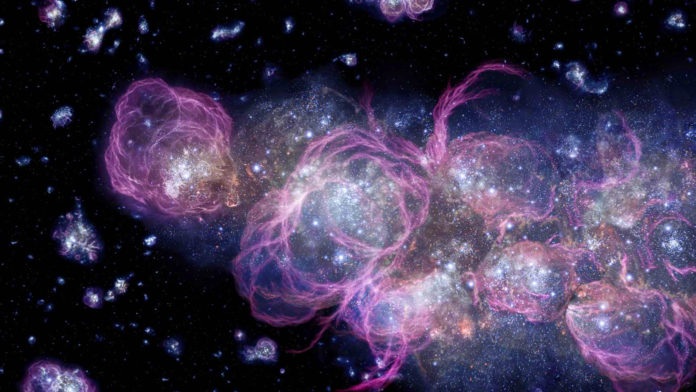After two decades of trying, scientists have finally succeeded in trapping atoms of antimatter for long enough to really study them.
In a world first, researchers at CERN in Switzerland shone laser light at a vacuum chamber of anti-hydrogen atoms to excite them. Every excited atom emits a signature pattern of wavelengths, or colours, of light as it returns to its ground state. After several minutes, the spectrum of specific wavelengths of light emitted by the excited anti-hydrogen was recorded and compared to the spectrum of regular hydrogen.
The Standard Model of particle physics, the leading theory of particles and their interactions, predicts that the spectral signatures of hydrogen and anti-hydrogen match. Down to experimental limits, this prediction was validated by the research team.
The results, published this week in Nature, were part of an international effort by the ALPHA collaboration, which included authors from several Canadian institutions: TRIUMF, the University of Calgary, the University of British Columbia, Simon Fraser University, York University, and the University of Victoria.
What exactly is antimatter?
All the familiar things we come in contact with in everyday life are made of matter: built from atoms with a positively charged core of protons and neutrons, surrounded by a cloud of negatively charged electrons. Antimatter is thought to be nearly identical, except the charges are reversed: a negatively charged core of anti-protons and anti-neutrons, and a positively charged shell of orbiting anti-electrons (also called positrons). Otherwise, matter and antimatter are thought to look and behave like one another.
When antimatter and matter collide, they destroy one another in a flash of light and high energy particles.
In theory, the Big Bang should have produced an equal amount of matter and antimatter. The world of matter we experience must have resulted from some sort of asymmetry, the nature of which remains a mystery.
Medical imaging already makes use of antimatter
It may surprise you to know that there is a technology that makes regular use of antimatter.
PET scans are a routine procedure used in medical imaging. The acronym stands for Positron Emission Tomography — and yes, by positron, they mean anti-electrons.
In essence, what is being imaged is matter-antimatter annihilation.
A radioactive tracer, like fluorine-18, is targeted to the area of the body to be imaged. Radioactive decay produces positrons, which are nearly instantly annihilated when they encounter any of the electrons that surround them, producing two gamma rays that travel in opposite directions. These gamma rays are then detected, providing a three-dimensional model of the area targeted by the tracer.
Why is trapping anti-hydrogen special?
In PET scans, positrons are useful because of how immediately they are destroyed and converted into gamma rays. For the same reason, it is impossible to find naturally occurring anti-hydrogen on Earth because it is so rare and short-lived. To measure the spectral signature of anti-hydrogen, scientists needed a way to to make and store it for long enough to run the test. When antimatter comes in contact with the walls of its trap, it is immediately destroyed, making storage a challenge.
Hydrogen is the simplest atom that exists. It consists of a single proton orbited by a single electron. By extension, anti-hydrogen has a single anti-proton orbited by a single positron.
The first atoms of anti-hydrogen made at CERN in 1995 were highly energetic, travelling at speeds close to the speed of light. They only made it 10 meters, or 40 billionths of a second, before being annihilated by ordinary matter.
The process has since been refined to slow the particles down for capture. To make anti-hydrogen, anti-protons and positrons are first made and held separately. Their charges make them relatively easy to trap in a near perfect vacuum, keeping them away from matter using electric fields. When ready, the ALPHA researchers nudge the two together to create low-energy anti-hydrogen atoms.
Once combined, they lose their electric charge, and the electric fields can no longer hold them. Two strong superconducting magnets create a new trap, taking advantage of the weak magnetic properties of anti-hydrogen. Of the 50,000 anti-hydrogen atoms that the ALPHA team can create in each attempt, only an average of 14 anti-atoms can be held for a 15-minute test. However, this is much higher than the previous average of 1.2 anti-atoms, allowing the team to probe their spectral properties.
What’s next?
Even tiny differences between the spectral properties of hydrogen and anti-hydrogen would break basic principles of modern physics. However, any new understanding could help solve the mystery of the matter-antimatter imbalance. Further improving anti-hydrogen storage will help researchers obtain even more precise results, for a better understanding of antimatter and the nature of the universe.
Now that it is possible to probe the spectral properties of antimatter, this work will open up many new possibilities in the study of particle physics.








































